New species of tyrannosaurus discovered in China

A team of paleontologists from the Natural History Museum in Zhejiang, China, has reported the discovery of a new species of tyrannosaur, a dinosaur with a distinctive long
The first deep-snouted tyrannosaur from Upper Cretaceous Ganzhou City of southeastern China | Scientific Reports
https://www.nature.com/articles/s41598-024-66278-5

New species of tyrannosaurid dinosaur identified in China
There are about 30 species of Tyrannosaurus, all of which are known for their large size and large, deep snouts with sharp teeth. Fossils have been found in what are now North America and Australia, as well as in Asia, including China and Mongolia.

In China, a large number of dinosaur fossils, including Tyrannosaurus, have been found in a geological layer called the '
The dinosaur reported this time has been named 'Asiatyrannus xui'. The genus name is a combination of 'tyrannus', meaning 'king' or 'tyrant', and Asia, and the specific name is taken from paleontologist Xing Xu, who made a great contribution to dinosaur research in China. Scientists also described 'Asiatyrannus' as a new subfamily.
Asiatyrannus xui was originally discovered in September 2017 at a construction site in Shahe Town, Nankang District, Ganzhou City, Jiangxi Province, and many parts of the skull, including a nearly complete skull, a partially disarticulated postcranial skeleton including the caudal vertebrae, a right femur, a tibia, and a fibula, were reconstructed.

Its distinctive feature was its long snout. The Qianzhousaurus is also known for having a 'long nose,' but Asiantyrannus xui has a skull that is only half the size of the Qianzhousaurus, but it was found to be similarly long compared to other species. At the time of writing, only one species, Asiantyrannus xui, was confirmed to be a tyrannosaurus that lived in the southernmost part of Asia, and scientists speculate that it probably ate relatively small and fast prey because it was smaller in size than other tyrannosaurus.

Related Posts:
in Creature, Posted by log1p_kr







